 |
 |
 |
| |
Adverse Event Rates Similar With High-Dose ATV/r and LPV/r During Pregnancy
|
| |
| |
53rd ICAAC, September 10-13, 2013, Denver
Mark Mascolini
Adverse events were frequent but mild in US HIV-positive women taking high-dose atazanavir/ritonavir (ATV/r) or lopinavir/ritonavir (LPV/r) during pregnancy in a nonrandomized retrospective comparison [1]. An overall toxicity metric did not differ between women taking ATV/r and those taking LPV/r. Three quarters of adverse events were grade 1, and only 2 of 65 women had to stop treatment.
Because protease inhibitor (PI) concentrations often fall during pregnancy, higher doses have become standard. Yet data on antiretroviral-related toxicities and adverse events during pregnancy remain limited. To address that issue, Chicago researchers conducted this retrospective, single-center study of HIV-positive women taking high-dose ATV/r (400/100 mg once daily) or high-dose LPV/r (600/150 mg twice daily) during pregnancy at some point between September 2007 through January 2013. The primary outcome was a composite endpoint of the between-group difference in adverse event rate, PI discontinuation, PI dose reduction, and symptomatic therapy related to an adverse event.
The analysis focused on 65 women, 13 taking high-dose ATV/r and 52 taking high-dose LPV/r. The ATV/r and LPV/r groups were similar in average age (29.1 and 29.5), median weight (72.8 and 68.5 kg, P = 0.27), HIV infection duration (7.4 and 8.8 years), and race (about two thirds African American or black African). Time to upward dose adjustment was significantly shorter in women taking ATV/r than LPV/r (median 137 versus 188.5 days, P < 0.05) because ATV labeling recommends dose escalation during the second trimester. The most frequent backbone drugs were tenofovir/emtricitabine in the ATV/r group (84.6%) and zidovudine/lamivudine in the LPV/r group (55.8%).
Percentages of women with an undetectable viral load were similar with ATV/r and LPV/r in the first trimester (45.4% and 44.4%), second trimester (76.9% and 60.0%, P = 0.34), and the third trimester (77.0% and 84.2%, P = 0.32).
Eleven women in the ATV/r group and 44 in the LPV/r group (84.6% and 84.6%) met the primary composite adverse event endpoint. A somewhat higher proportion of women taking ATV/r than LPV/r had a lab abnormality (10 women, 52.6% versus 32 women, 31.7%, P = 0.08), mostly because of hyperbilirubinemia.
Rates of clinical interventions were similar with ATV/r and LPV/r, including symptomatic therapy for an adverse event (31.6% and 42.6%), antiretroviral discontinuation (8% and 8%), and antiretroviral dose reduction (0 and 4.6%). Transaminitis led to the dose reductions in the LPV/r group. One woman in each group stopped antiretrovirals, one for constipation in the ATV/r group and one for anemia in the LPV/r group.
Hyperbilirubinemia proved the most the most frequent adverse event with ATV/r (37%), followed by vaginal bleeding or discharge (16%), constipation (11%), and nausea or vomiting (10%). With LPV/r the most frequent adverse events were nausea or vomiting (17%), hyperbilirubinemia (16%), transaminitis (14%), diarrhea (12%), vaginal bleeding or discharge (12%), anemia (11%), and pruritus or rash (11%).
The researchers concluded that these women tolerated high-dose PIs well, as indicated by the low discontinuation rate in both groups.
Reference
1. O'Brien C, McLaughlin M, Scarsi K, Gerzenshtein L. Tolerability of high dose atazanavir/ritonavir versus lopinavir/ritonavir during pregnancy in HIV-infected women. 53rd ICAAC. September 10-13, 2013. Denver. Abstract H-1259.
-------------------------------------------------------------------
Tolerability of High Dose Atazanavir/ritonavir versus Lopinavir/ritonavir during Pregnancy in HIV-Infected Women
Reported by Jules Levin
Colleen A. O'Brien1, Milena M. McLaughlin1,2, Kimberly K. Scarsi1,3, Lana Gerzenshtein1
1Northwestern Memorial Hospital, Chicago, IL, 2Midwestern University Chicago College of Pharmacy, Downers Grove, IL, 3Northwestern University, Chicago, IL
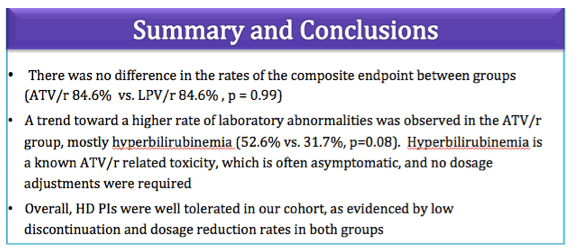
ABSTRACT
Background: Pharmacokinetic changes during pregnancy reduce antiretroviral drug exposure, supporting the use of high dose (HD) protease inhibitors (PIs), atazanavir/ritonavir (ATV/r) and lopinavir/ritonavir (LPV/r), during later stages of pregnancy. Data are lacking regarding the tolerability of HD PIs. This study sought to determine rates of adverse events (AEs) necessitating PI discontinuation, dosage reduction, or adjunctive symptomatic therapy in subjects on antiretroviral therapy (ART) during pregnancy.
Methods: This retrospective cohort included HIV-infected pregnant women receiving HD ATV/r or LPV/r-based ART between Sept 2007-Jan 2013. Toxicities were assessed by laboratory parameters and medical chart documentation from the first visit during pregnancy through delivery. Toxicity severity was based on the Division of AIDS Table for Grading the Severity of Adult AEs. The primary endpoint was a comparison between the groups of a composite of the AE rate, symptomatic therapy initiation related to AEs, dose reduction or discontinuation of the PI.
Results: During the study period, 65 patients were identified for analysis (n=13 ATV/r, n=52 LPV/r). Patients were 29 years old, primarily black (65%), and been HIV-infected for 8 years. There were 11(84.6%) composite endpoints in the ATV/r group and 44 (84.6%) in the LPV/r group (p=0.99). The most common AEs in the ATV/r group were hyperbilirubinemia (37%) and vaginal bleeding (16%), while nausea/vomiting (17%) and hyperbilirubinemia (16%) were most common in the LPV/r group. A high number of patients required adjunctive symptomatic therapy in both the ATV/r and LPV/r groups (31.6% versus 42.6%; p=0.41), yet most of the AEs did not exceed Grade 1 in severity (78.9% versus 70.3%, respectively; p=0.58). No subjects in the ATV/r group and 3 (5.8%, transaminitis) subjects in the LPV/r group required a dose reduction (p=0.99). One patient required discontinuation of PI therapy in each group (ATV/r, constipation; LPV/r, anemia; p=0.36).
Conclusion: No difference in toxicities was observed between subjects receiving either HD ATV/r or LPV/r during pregnancy. While reassuring, ongoing pharmacovigilence and larger cohort evaluations are required to validate these results.
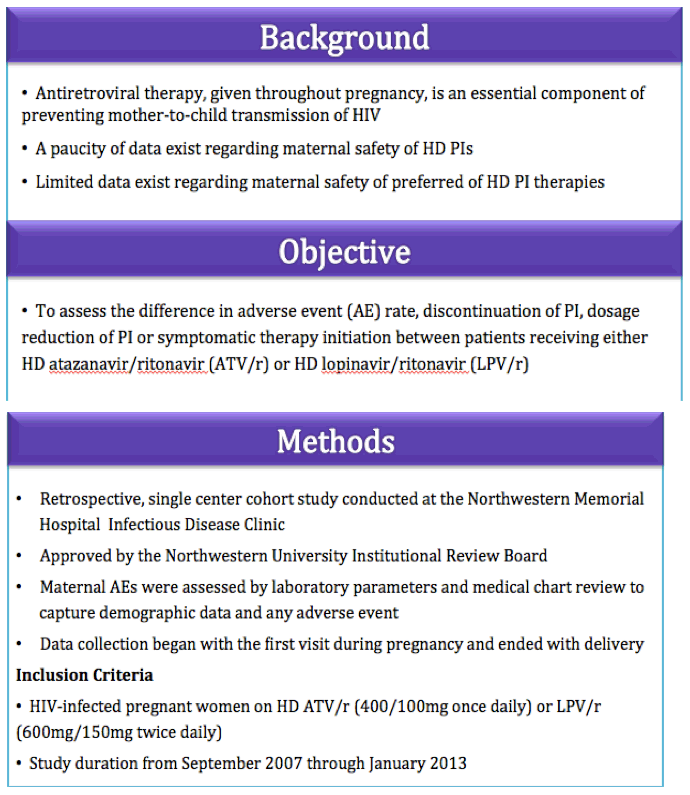

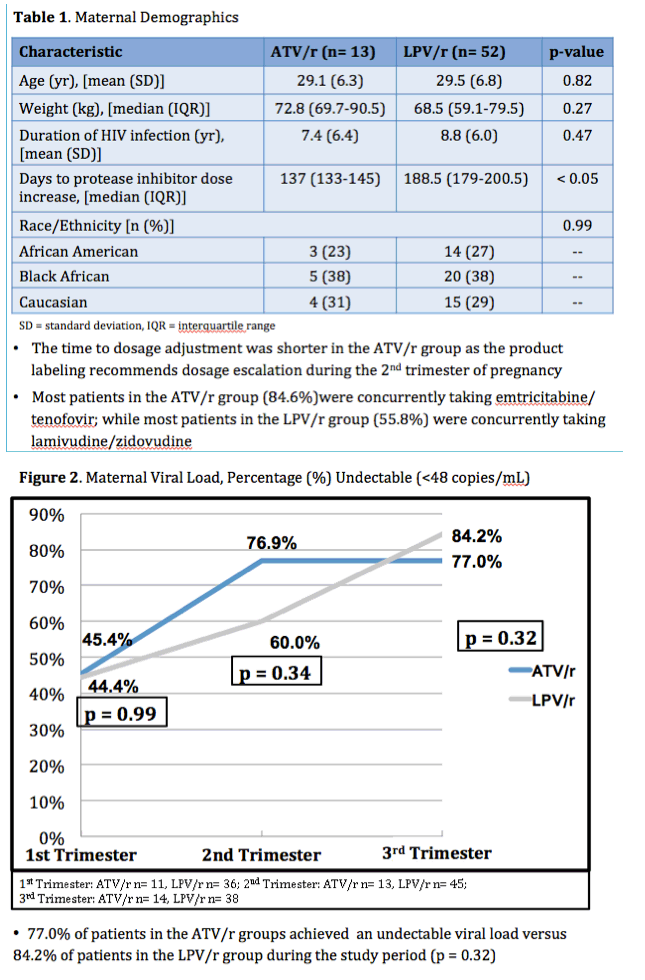
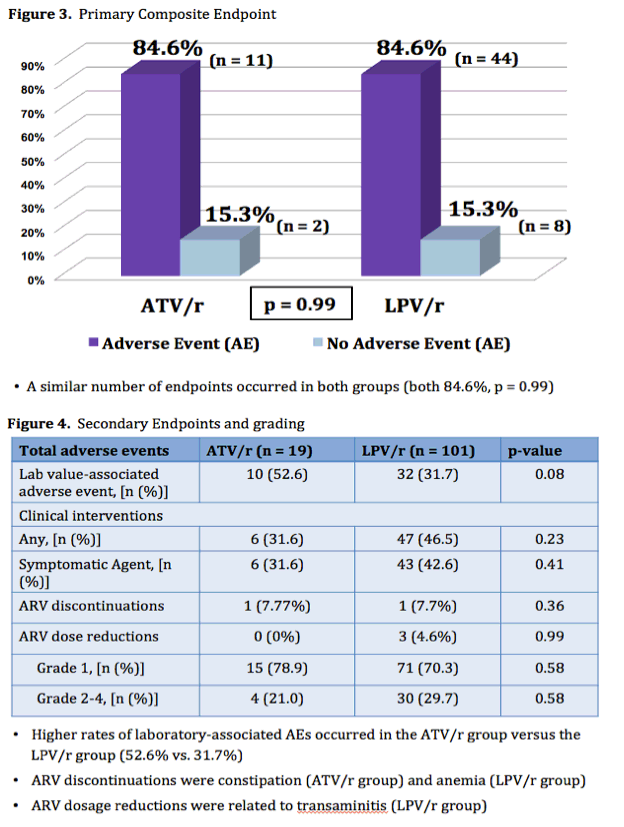
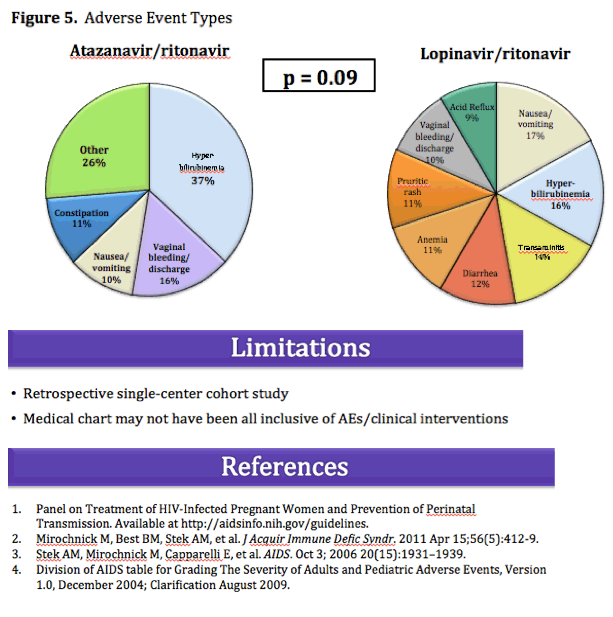
|
| |
|
 |
 |
|
|